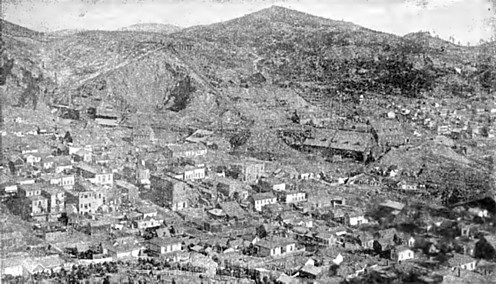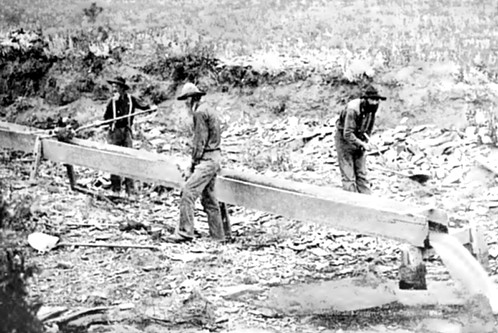Closely embraced between
the two principal forks of the Cheyenne river arises a magnificent group of
mountains
extending about one hundred miles north and south and about sixty miles
east and west direction. To this group of mountains
the great Dakota or Sioux nation gave the name of Pa-ha-sap-pah, or Black
Hills. The first inhabitants of the Black Hills of whom we have any
authentic information are the people of the Crow Nation. According to their
tradition they formerly occupied the whole range of the Rocky Mountains with
the beautiful valleys on both sides, from the Saskatchewan in the north and
as far south as the mountains continue.
The discovery of gold here would change things forever.
While exploring the area, on the 3d of August 1874, General Custer made a
report in which he says: "It will be understood, that within the limits of
the Black Hills in we were almost constantly marching, we have established the
fact, that gold is distributed throughout the extensive area within the
Black Hills. Gold was obtained in numerous localities in what are termed
gulches. No discoveries, so far as I am aware, were made of gold deposits in
quartz, although there is every reason to believe, that a more extended and
thorough search would have discovered it. No large nuggets were found; the
examination, however, showed that a very even, if not a very rich,
distribution of gold is to be found throughout the entire valleys. In other
words the "prospecting" showed that while the miner may not in one pan full
of earth find nuggets of large size or deposits of astonishing richness, to
be followed by days and weeks of unrewarded labor, he may reasonably expect
in certain localities to realize from every pan full of earth a handsome
return for his labor."
Below is a collection of 20 tales of adventure and history from South Dakota's early gold mining days:
1. Black Hills Gold Discoveries
2. The First City In the Black Hills Organized
3. Early Day Dakota Black Hills Mining
Laws
4. Gold Bearing Streams and Rivers of the Black Hills
5. Deadwood City’s Early Gold Mining History
6. The Cost of Pioneer Living in Deadwood
7. The Deadwood Placers Yield Large Quantities of Gold
8. The Early History of Custer City and Nearby Towns
9. The Rich Gold Mines Of The Black Hills
10. The Famous Homestake Gold Mine
11. The Black Hills Silver Mines
12. The Bald Mountain Silver District
13. The Custer City Gold Mining District
14. The Black Hills Stage Coach Robberies
15. Archie Borland, Owner of the Black Hills Bonanza Mines
16. Rushing to Deadwood in the Black Hills
17. Discovery of the Golden Summit Mine
18. Father De Smet and the De Smet Gold Mine
19. Mineral Resources Of The Black Hills, Part I
20. Mineral Resources Of The Black Hills, Part II
21. Mineral Resources Of The Black Hills, Part III
Custer's Report continued:
"While I am satisfied that
gold in satisfactory quantities can be obtained in the Black Hills, yet the
hasty examination we were forced to make, did not enable us to determine in
any satisfactory degree the richness or extent of the gold deposits in that
region. Seeking for gold was not one of the objects of this expedition,
consequently we were ill prepared to institute or successfully prosecute a
search after it even after we became aware of its existence in the country." The expedition of General
Custer was accompanied by H. N. Ross and William T. McKay, in the capacity
of guides and miners. Before General Custer left the Hills he had expected
to be ordered to make an expedition to the Yellowstone and Big-Horn country;
where he subsequently lost his life; and Mr. Ross had agreed to accompany
him. After waiting for some time and the orders not arrived he suggested to
the General that the idea of an expedition had probably been abandoned, and
he desired to be freed from the obligation to accompany him, telling the
General at the same time that he was going to the Black Hills to look for
more gold. The General admitted that the proposed expedition
was probably off, and jocosely remarked that if Ross attempted to return to
the Black Hills he would be obliged to capture him and bring him back. Ross
with a sly twinkle in his eye replied: " General, I'll take good care you
don't capture me." "Now, Ross," said Custer, "if I were goings to the Black
Hills I would not fit out an expedition and start from the nearest military
post, but I would go off ten or fifteen miles, cross the Missouri river, and
instead of taking a well-known trail, strike out directly for the Bad
Lands." Ross profited by this advice. When about twenty-five miles south of
Bear Butte they struck Custer's exit trail. Their cattle were so worn out by
forced driving day and night, to avoid Indians and soldiers, that it became
necessary to lighten up the wagons by packing everything they could get on
their ponies. After doing this they followed up the trail, and reached
Custer's Park on the 24th of December, 1874.
Two hours after pitching camp in Custer's Park, Charley Cordero and little
Bob Talent found one of the prospect holes made by McKay and Ross, of the
Custer party, and
obtained from it a good prospect. This was the first gold found by the
party, and they all thought their fortunes were made; and the company were
in consequence highly elated and full and overflowing with days work, and
exuberant spirits. Christmas day was celebrated with every pomp that their
limited resources would admit of. They settled in for the winter, but by
April 6, 1875, the miners were forced to leave. They were carried to
Cheyenne where they remained until the 19th of July, when a portion of them
slipped quietly away at night and headed for the gold fields. The soldiers
overtook them, arrested them and carried them back. They started again, and
were again arrested and carried back. This was repeated the third time; but
before getting back to Cheyenne they escaped, and finally reached the gold
fields of the Black Hills in October, 1875. The presence of white people in
the Hills contrary to the spirit of existing treaties with the Indians
compelled the United States Government to take notice of the matter. The
reports that had been brought in by the miners were now spread far and wide
over the West, and great excitement prevailed in the frontier settlements
bordering on the reservation and extended even into the thickly settled
regions of the East. The great floating population of the frontier, miners
and others, suffering from a dearth of mining discoveries, were now ready
for a
gold rush into this new El Dorado. It soon became evident
that there was a large body of miners ready to enter the new field, many of
whom expressed no wish to transgress the word of the Government given in the
treaty, and there was a very general desire, that the right to prospect and
mine should be acquired for them by the Government, either by purchasing the
Black Hills or by obtaining a concession from the Indians as was endeavored
in a subsequent council.
The mines of the Black Hills yield both gold and
silver ore, though the silver deposits were not discovered
till some time after active mining for gold had made the region widely
known. The gold mines may be included in four classes: 1. Placers. 2. Quartz
veins between slate walls. 3. Quartz veins between porphyry walls. 4. Cement
deposits. "The placers in the Black Hills are of great extent, and some of
them have yielded very large sums. Some of the dry places (that is, beds of
clay or gravel, containing a considerable amount of free gold, but at such a
distance from water are so rich that the dirt has been brought from some of
them by wagon loads to the water. In traveling through the Black Hills one
will notice along the numerous creeks vast piles of gravel. Through the
midst of these heaps of pebbles, among which now and then there towers up
the round back of a boulder, or rises a little grassy island, bearing some
charred stump, one may often see remains of wooden machinery and the ruins
of abandoned log cabins; or he may even meet with men at work, and learn how
the hasty little stream is made to pause and pay toll in service as it
rushes downward from the high cliffs where it was born. All these
appearances are signs of gold mining by the method known as "
placer-washing" or " gulch-digging." It is the simplest, and, in some
respects, the most interesting of all the processes by which the precious
metal is dug out of the earth.
According to some authorities Ed. Murphy and others from Montana visited
Deadwood gulch in the late autumn of 1875, and were the first discoverers of
gold. Murphy wrote to John Hildebrand, who in April, 1876, came on from
Montana bringing a considerable party with him. On the 13th day of November
Frank Bryant found gold in Deadwood while hunting deer, and on the 15th of
the same month he, with one of his party, commenced to prospect Deadwood
gulch. The thirst for gold overcame all difficulties, brought thousands of
gold miners to these wilds, and in less than a year Deadwood grew from a few
log cabins to a city of seven thousand inhabitants, with buildings and
improvements that were valued at one million of dollars and business in
proportion. Gold dust was the medium of exchange and everybody carried a
sack or bottle to hold their change. Every place of business kept gold
scales to weigh out the change required. Everything had two prices, one for
gold and the other for greenbacks; the currency price being ten per cent
less than the gold price. The placers yielded fabulously, and
gold quartz brilliant with the yellow metal passed from hand
to hand. Speculation in town lots amounted to a furor of the wildest kind.
Lead, once the largest city west of the Missouri river, in South Dakota, began
its history in the spring of 1876, when gold was discovered in the
surrounding hills and gulches. At this time the immense lead now known as
the Homestake property, was then unknown and covered with heavy timber. At
first a few miners' cabins were built along Gold Run Gulch, and the
occupants were engaged in placer mining. Soon after prospecting for
quartz began, and the Emanuel Brothers, where the cut now is,
discovered the
Homestake
gold mine. Soon after they found the Old Abe; then
followed the discovery of the Highland by M. Cavanaugh, and the Golden Star
by Smoky Jones. Little could be done with the
gold ore until a mill was built, but some was reduced in an
arastra in Pennington, by the Emanuel Brothers, being ore from the Homestake
mines. The spring of 1877 gave birth to the first stamp mill, built by
Messrs. George Beemer & Co., near where the D. C. depot now stands. Stamps
began dropping April 15, 1877.

Above: Lead, South Dakota in the early gold rush days

